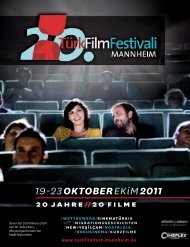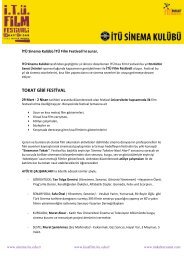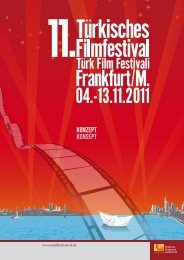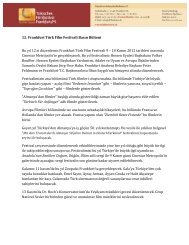You also want an ePaper? Increase the reach of your titles
YUMPU automatically turns print PDFs into web optimized ePapers that Google loves.
CINEMA IN TURKEY: INSPIRATION ACROSS GENERATIONS<br />
By Zeynep Dadak<br />
With its mission to celebrate world cinema, The Film Society of Lincoln Center has collaborated with the <strong>Moon</strong> <strong>and</strong> <strong>Stars</strong> <strong>Project</strong> of The<br />
American Turkish Society, which is dedicated to promoting cultural interaction between the United States <strong>and</strong> Turkey, on the most<br />
comprehensive film program on Turkish cinema in the United States. ‘The Space Between: A Panorama of Cinema in Turkey’ aims to map<br />
cinema in Turkey through historical turning points <strong>and</strong> prevailing trends, the relations between artistic <strong>and</strong> political realms, the generational<br />
gaps <strong>and</strong> continuities. In a sign of exp<strong>and</strong>ing interest in the innovative cinema coming out of Turkey, this elaborate program goes<br />
beyond highlighting the history of ‘currently fashionable.’ Contributing to a vibrant dialogue between audiences <strong>and</strong><br />
filmmakers from different parts of the world, ‘The Space Between’ also addresses thriving possibilities in Turkish cinema.<br />
For over a decade now, a group of auteur filmmakers from Turkey have been cultivating an ever-growing audience of admirers <strong>and</strong><br />
followers, both home-grown <strong>and</strong> from elsewhere around the world. Through their prolific filmographies, a significant turn in contemporary<br />
Turkish cinema may be observed beginning from the mid-Nineties, where state-funded co-productions with predominantly European<br />
funders have allowed for the emergence of individual styles of filmmaking. Derviş Zaim’s Tabutta Rövaşata (Somersault in a Coffin),<br />
Yeşim Ustaoğlu’s Güneşe Yolculuk (Journey to the Sun), Zeki Demirkubuz’s İtiraf (Confession) <strong>and</strong> Yazgı (Fate), Nuri Bilge Ceylan’s<br />
Uzak (Distant), İklimler (Climates) <strong>and</strong> Bir Zamanlar Anadolu’da (Once Upon a Time in Anatolia), Reha Erdem’s Beş Vakit (Times <strong>and</strong><br />
Winds) <strong>and</strong> Kosmos, Semih Kaplanoğlu’s Süt (Milk) <strong>and</strong> Bal (Honey), all became global festival hits in recent years.<br />
THE PIONEERS<br />
The independent filmmakers of the Nineties emerged at a time when Yeşilçam, the popular film industry in Turkey that had produced<br />
250 films a year during its apex in the Sixties <strong>and</strong> the Seventies, ground to a halt in the post-coup d’état climate of the Eighties. Back in<br />
the Sixties, despite the fact that Yeşilçam mostly relied on genre-based production <strong>and</strong> the star system, visionary directors such<br />
as Yılmaz Güney, Lütfi Ö. Akad, Metin Erksan, Halit Refiğ <strong>and</strong> Atıf Yılmaz catered to an auteur cinema. The aforementioned filmmakers<br />
looked into ways in which they could incorporate into their realistic style, the inspiration they gathered from Italian, French <strong>and</strong> Latin<br />
American auteur filmmakers. This effort included prospects of finding ways to channel the local narratives into an innovative film<br />
language. Metin Erksan’s Yılanların Öcü (Revenge of the Snakes), Susuz Yaz (Dry Summer), Halit Refiğ’s Gurbet Kuşları (Birds of<br />
Exile) <strong>and</strong> Lütfi Ö. Akad’s Hudutların Kanunu (The Law of the Border) are quintessential examples of this thread. That said, these<br />
directors always remained a part of Yeşilçam <strong>and</strong> had to respond to the needs of the industry by producing genre films. Yılmaz Güney<br />
took the road to Yol (The Road), directed by Şerif Gören, in reverse. Güney started his film career as a popular actor, an action hero,<br />
also known as ‘Çirkin Kral’ (The Ugly King). Drawing on his popularity to disseminate his revolutionary ideas, in Umut (Hope), Güney<br />
lent his prestige <strong>and</strong> box-office clout to the ‘cause.’<br />
With the decline of the film industry throughout the Eighties, only a few names continued to develop a sense of auteurism. Among them<br />
are Ömer Kavur, Erden Kıral, Ali Özgentürk, Şerif Gören <strong>and</strong> Zeki Ökten. Ömer Kavur, one of the first generation of directors coming<br />
from a film school background, made films with a rigorously conceptualized cinematic framework. His film education in France gave<br />
him a rather unique yet distant place among fellow filmmakers, especially in terms of political engagements. The other four had all<br />
previously worked as Yılmaz Güney’s assistant or co-director, <strong>and</strong> had to confront the aftermath of the 1980 coup, both in their personal<br />
lives <strong>and</strong> films. Meanwhile, Atıf Yılmaz was in his artistic prime, exploring new dimensions in self-reflexive narration. From Ah Güzel<br />
İstanbul (O Beautiful Istanbul) to Aaah Belinda (Oh Belinda), he used photography <strong>and</strong> film to set an alternate universe in Istanbul,<br />
especially through women characters’ point of view. Similarly, self-reflexive cinematic realism from a female perspective informed Benim<br />
Sinemalarım (My Cinemas) by women filmmakers Gülsün Karamustafa <strong>and</strong> Füruzan, making the film a part of two major trends<br />
simultaneously: women’s films depicting female characters in search of their identities, <strong>and</strong> films dealing with cinematic practice itself in<br />
terms of creative desires, <strong>and</strong> disappointments in realizing a film.

















